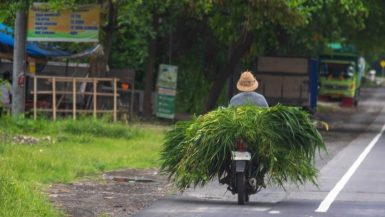
Among the luxury villas, powdery white sand beaches, and miles of lush paddy fields, Bali is home to a diverse and stunning array of wildlife which will tell you a lot about the local culture.
From the populous geckoes to the rarest big cats, Bali wildlife should be on your radar. Whether you want to know which species to avoid or make it your mission to spot some of these majestic creatures in the wild, knowing what to expect before venturing to the Islands of the Gods is a good idea.
Our guide runs through some of the unique animals native to Indonesia that you might just find in Bali, whether it’s in the depths of the jungle or the leafy backyard of your homestay. We even include some of the local names in Bali’s accessible Bahasa tongue so you can use them on your adventure to paradise. Let’s get into it.
Komodo Dragon

They’ve thrived in Indonesia’s Lesser Sunda Islands for millions of years and are believed to be the closest surviving relative to the dinosaur. Komodo dragons are Bali’s most formidable predators and are unique to Indonesia’s wildlife.
With a powerful, thrashing body, sharp teeth, and claws, you’d be lucky to escape the jaws of this giant lizard. But the deadly venom in its saliva would surely seal your fate. They originate from the Komodo National Park, hence the name, and live free and exclusively in Flores, preferring the tropical forests of the Rinca and Padar islands.
You can’t see Komodo dragons in the wild in Bali, but they can be found at the Bali Safari and Marine Park in Gianyar. Also, large monitor lizards from the same family as the Komodo have been spotted in Bali neighborhoods, even those as populated as Canggu. This variety of lizards is a similar size to the Komodo and is recognized by its swaggering walk. They do pack a powerful bite but are non-poisonous. Still, they should be given a wide berth if spotted in the wild.
Bali Starling

Found in the northwestern islands off the coast of Bali, the Bali Starling is a striking but endangered native bird. Easily identified by its snow-white body, distinctive blue skin around its eyes, and the plume of white feathers atop its head, the bird is used in much of the cultural art in Bali.
The starling is locally known as the Jalak Bali or the Rothschild’s Mynah, after the British ornithologist who financed the collection of the species after its discovery in 1912. The illegal trade of songbirds has led to their critically endangered status, but they can be spotted on rare occasion in flocks of 20 to 30 along the mountainous regions and coast of North Bali.
Because of the bird’s rarity, it goes for extremely high prices in Denpasar’s lucrative cage-bird trade, and possessing the startling in a private collection is considered a status symbol. This has led to poachers seeking out the bird more so in recent years, as well as deforestation for tourism in the bird’s natural habitat contributing to its near-extinction.
The Bali Starling Project has made efforts to help the Jalaks recover, and they are thought to have been introduced successfully in Nusa Penida.
Sumatran Tigers

The smallest surviving tiger subspecies, threatened by poaching and deforestation, are the beautiful Sumatran Tigers that can be found on the Indonesia island of the same name. With fewer than 400 left in the wild, these majestic creatures can be recognized by their striking orange and brown far, heavy black stripes, and more bearded and maned appearance than other tigers. This has made them sought-after for the illegal wildlife trade, and they continue to face rapid population decline.
Sumatran tigers are known to be very timid and stay shy of people but also outright aggressive to anything that poses a threat to them in their habitat. They prey on wild pigs and deer but are also non-selective, opportunistic feeders.
They allegedly used to populate Java and Bali but can now only be found on Sumatra, the large western Indonesian island, where they roam the lowland forests and mountainous regions. They can be found in several unprotected areas, but the Gunung Leuser National Park is thought to be home to the largest remaining population.
Orangutans

More than three-quarters of the world’s orangutans are thought to live in the forests of Indonesian Borneo, but they once thrived in jungles all across Asia, from Bali to China.
Forever a crowd favorite, these cuddly and friendly giant apes might be found in your local zoo, navigating rope courses and entertaining onlookers, but Sumatra is one of the only places they can be seen in the wild. In fact, the Leuser Ecosystem, a collective name for the immense national park and biosphere reserve on the Indonesian island, is the only place globally where orangutans coexist with tigers, elephants, and rhinos.
Orangutans are among the rarest and most intelligent apes and living creatures. Mining, logging, and deforestation, primarily due to the destructive palm oil industry, have put orangutan populations into rapid decline.
Declared critically endangered in 2016, the Sumatran orangutan has been subject to concentrated conservation efforts in recent years. Still, balancing human-animal conflict, even in protected areas like the Leuser Ecosystem, which four million people rely on for livelihood and drinking water, proves problematic.
Bali ‘Sapi’ Cow

There are few, if any, nations in the world where you won’t find cattle both in the wild and privately farmed. But Bali’s local sapi, meaning cow, is world-famous, unique because of its widespread immunity to diseases for which most cow species have no defense. Cattle are also fundamental for Balinese families, but not just for their produce.
Bali cows are used to plow rice fields more often than they are for meat production. Far cheaper than an automatic plow, cows in Bali allow families to be self-sustainable. Balinese cows are typically a rusty light brown in color, and you can find them roaming freely wherever there is grass.
There is a mutton industry in Bali, but it mainly caters to tourists as cows are sacred to Hindus, and most Balinese refrain from eating beef.
House Geckoes

House geckoes, known locally as totek, are signature of Bali wildlife and can be found everywhere on the island, but mostly climbing up shaded walls, scuttling along with balconies, and chilling in outdoor showers. They don’t like air conditioning, but, likely, you’ll still see them inside your accommodation, and you shouldn’t fear them.
They make a lot of noise, especially at night when they’re chasing each other and catching insects. Still, a few of these guys around should help control the populations of other bugs in your Bali villa.
They vary in size, but most have a relatively translucent and pale body and don’t grow much bigger than 12 inches long. Most will scurry away quickly and are very shy of humans and animals if approached. Larger totek have been known to have a powerful bite, but it’s unlikely you’ll ever get close enough to one to get nipped.
Snakes

In Bali, there are a whopping 46 known species of land snakes and a number of freshwater ular. Only six terrestrial species are venomous, but all 18 ular laut or ‘sea snakes’ that populate the waters off Bali are thought to be the most poisonous. Still, reported sightings from divers, swimmers, and snorkelers are very rare.
Spitting cobras, king cobras, green pits vipers, two sorts of krait, and the Asian coral snake, which, contrary to its name, is a land snake, all carry potent venom.
The Sumatran spitting cobra, or Naja Sumatran, and Javan cobra, Naja sputatric, are both native to Indonesia and can be found all over the Lesser Sunda Islands of Indonesia, including Bali, Lombok, Sumbawa, Flores, and Komodo. Brown in color, they can be found in rice fields and gardens where they hunt rats, but they have been known to be attracted to houses. Although highly venomous, anti-venom is available in most hospitals because of how widely present this formidable snake species is.
The Trimeresurus insularis is another venomous viper found in eastern Java and the Lesser Sunda Islands, but sightings have been recorded in busy Bali neighborhoods. As it is known in English, the White-lipped Island pitviper is impossibly beautiful with vibrant green color, despite its name. The rarer variety of the snake is actually a luminescent baby blue and can be found in Komodo, coexisting with the green viper.
You can avoid encounters with snakes in your holiday villa if you keep your environment clean and organize clutter. Lemongrass is also thought to deter snakes. It is not uncommon for snakes to come up through toilets, so always keep your lid closed and check under the seat before sitting down.
Are there big cats in Bali?
There are three subspecies of tigers that are native to Indonesia, but the only surviving variety is the Sumatran tiger. There are thought to be only 400 Sumatran tigers left in the world due to the illegal Bali wildlife trade and mass deforestation. The Javan tiger and Bali tiger were declared extinct in 2003 by the IUCN due to hunting and a lack of prey. The Sumatran tiger can still be found in the forests and mountains of Sumatra, with the most significant numbers living in the national parks. Still, some exist in unprotected areas, and populations here will undoubtedly continue to decline.
Are there crocodiles in Bali?
They might more readily be associated with the African Nile. Still, saltwater crocodiles or Buaya muara can be found in estuaries and open waters in Indonesia, traveling great distances even to beaches. They dwell in the sweet spot where fresh water runs into the ocean and allegedly even on Bali beaches. But sightings are infrequent, and there is no established crocodile population in Bali. However, they are common in East Timor at the far end of Indonesia, where their populations are secure. In fact, the fatality risk from crocodile attacks is ten times greater than from malaria here! Still, in Bali, they pose no real threat to humans.
Does Bali have poisonous spiders?
There are several poisonous spiders in Bali, but none pose an imminent threat to humans. They produce very weak venom that won’t do much harm beyond swelling and irritation, and most bites shouldn’t need treatment if they’re kept clean and relieved by an ice pack or cold compress. Still, it’s unlikely that a spider will bite you in Bali because venomous spiders typically only bite when threatened or provoked.
The home-wood spider is one of the most common varieties found inside in Bali. They’re recognizable by their longer bodies and legs and dark brown color. But these spiders are don’t have venomous glands and could help rid your villa of mosquitos and other insects.


